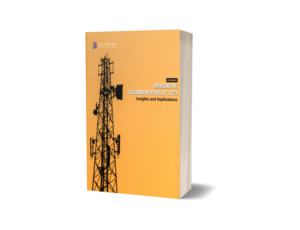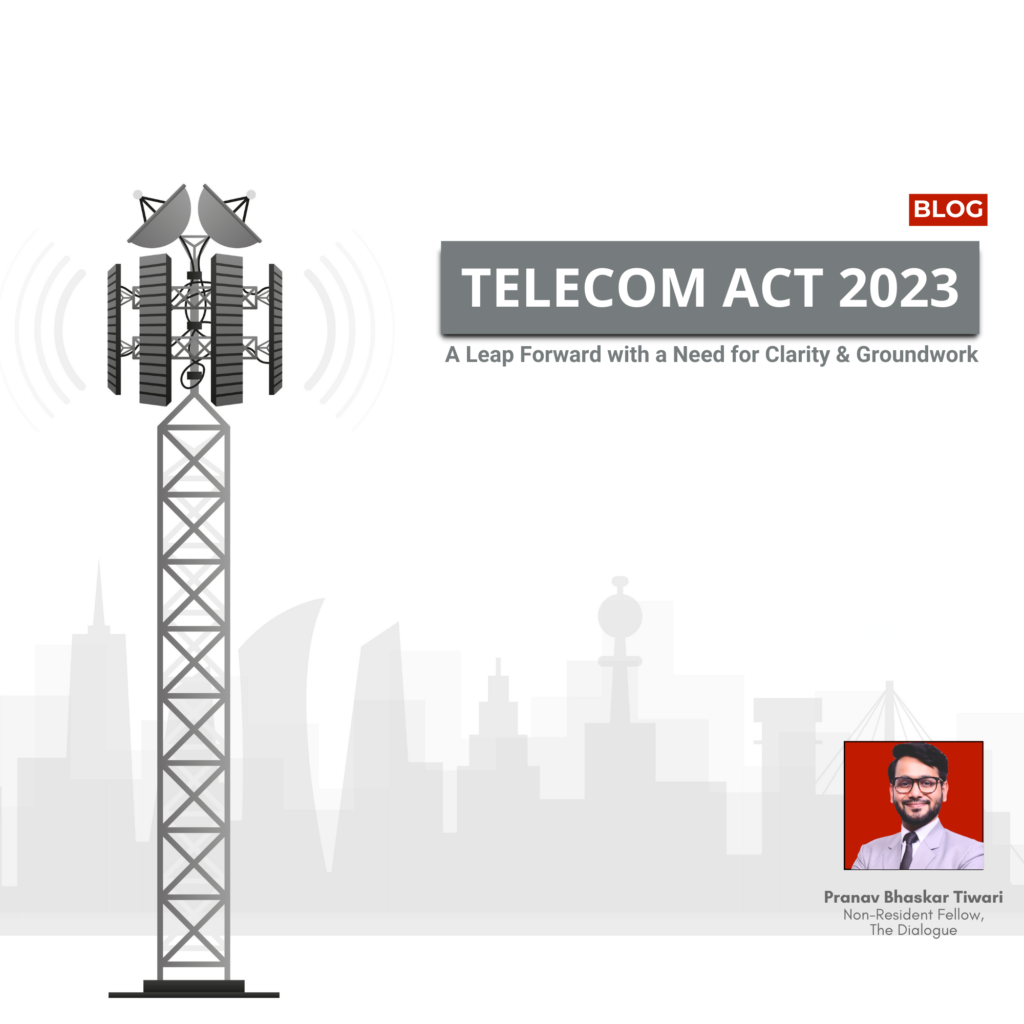Author : Pranav Bhaskar Tiwari, Non-Resident Fellow
A Progressive Legislation
The Telecommunications Act of 2023 represents a transformative and forward-looking shift in India’s regulatory framework for the telecommunication sector. It marks a significant departure from historical statutes, specifically replacing the Indian Telegraph Act of 1885, the Indian Wireless Telegraphy Act of 1933, and the Telegraph Wires (Unlawful Possession) Act of 1950. The 2023 Act departs from its predecessor, the 2022 Bill, by adopting a more nuanced and holistic approach. Importantly, the 2023 Act consciously avoids a converged regulatory model for traditional telecom and Internet-based service providers, limiting the definition of ‘telecommunication service’ to the telecom sector. This underscores the Central Government’s commitment to ensure that each sector has its distinct and appropriate regulatory framework, reflecting the unique challenges and dynamics of the traditional telecom sector and the rapidly evolving Internet-based services.
The 2023 Act introduces innovative elements such as a regulatory sandbox, streamlined frameworks for mergers and acquisitions, and efficient spectrum assignment. Additionally, the establishment of the Digital Bharat Nidhi, replacing the Universal Service Obligation Fund, marks a strategic move towards effective resource utilisation in enhancing digital infrastructure.
One of the Act’s most significant improvements is the refined definition of ‘telecommunication services’ in Section 2(t). The 2022 Bill’s broader definition under Clause 2(21) risked categorising OTT communication platforms as telecom services. This could have led to an undue compliance burden, particularly on smaller entities, while hindering innovation, competition, and business uncertainty emanating from regulatory overlaps in addition to privacy infractions for users. The 2023 Act’s revision rectifies this by setting clear boundaries on what potentially constitutes a telecommunication service, thus providing regulatory clarity and fostering a more conducive environment for technological advancement and investment.
Ambiguities and Concerns
Despite these advancements, there have been inconsistent interpretations on certain aspects including the definition of ‘telecommunication’ in Section 2(p) of the 2023 Act. This provision, using terminology akin to the definition of ‘telegraph’ in Section 3(1AA) of the Telegraph Act, appears to restrict its application solely to the telecom sector. However, its broad wording encompasses the transmission, emission, or reception of messages through various mediums, including electromagnetic systems. It also covers messages that have been altered during transmission, such as through encryption or compression.
This broad ambiguous definition has the potential to inadvertently bring Internet-based communications applications like Signal within its scope. Signal, for instance, utilises electromagnetic systems for message transmission – including wireless signals for WiFi or cellular data, and wired systems like optical fibers for Internet connectivity. Furthermore, applications like Signal messages undergo various forms of processing, including encryption and compression, fitting the provision’s description of rearrangement and computation during transmission. Such a broad interpretation might lead to ramifications for such platforms, our digital economy, and the users.
The Need for Clarification
The 2023 Act represents a significant step in refining India’s regulatory framework in the telecom sector. However, there remains a need for explicit clarification regarding the definition of telecommunication, particularly in its application to Internet-based communication services.
Section 2(p) of the 2023 Act is stylistically reminiscent of the language used in the historic Telegraph Act. Its literal interpretation, coupled with years of judicial interpretation, confines its application primarily to the traditional telecom sector. This historical context is crucial because it underpins a long-established legal understanding that distinguishes between traditional telecommunication services and modern Internet-based communication services.
This distinction is significant in today’s digital era, where the convergence of telecommunications and the Internet presents novel regulatory challenges. Although the legal interpretation of Section 2(p) suggests that it does not target Internet-based communication services, a formal clarification from the Ministry would be immensely beneficial.
Moreover, an explicit clarification by way of issuing FAQs or the addition of a proviso to Section 2(p) that expressly restricts its application to Internet-based communication services would be important. This would align the Act’s application with the current technological landscape and legislative objectives. It would provide much-needed certainty in the digital communication sector.
Laying the Groundwork
The enactment of the Telecommunications Act, 2023, is a watershed moment in India’s quest to revolutionise its telecom sector. However, the real litmus test for this legislation lies in the intricacies of its implementation, particularly during the rule-making stage. This stage is not merely a procedural step but a pivotal juncture that will shape the effectiveness, adaptability, and future-readiness of India’s telecom landscape.
Firstly, the power of authorisation and assignment under this new regime necessitates a nuanced approach. Simplifying authorisation processes is crucial to alleviate compliance burdens, fostering a more competitive and innovative environment. Clear and streamlined procedures must be developed to encourage new entrants and stimulate market dynamism. This will not only drive technological advancements but also ensure that the benefits of telecom expansion reach the furthest corners of the country.
Biometric verification, a cornerstone of modern telecommunication, presents a delicate balance between security and privacy. The rule-making stage must address this by limiting the scope of biometric verification to specific, necessary contexts. The introduction of privacy-respecting alternative modes of authentication is essential to maintain this balance. This approach will reassure users about the safety of their personal data, fostering trust in the telecom ecosystem.
The administrative allocation of satellite spectrum is another critical area. Rules developed here must strike a balance between efficient governance and reducing bureaucratic complexities. The allocation process should be practical, strategic, and in alignment with the global best practices. This will enable the swift and effective deployment of satellite-based services, crucial for a country as vast and diverse as India.
Furthermore, it is essential to collaborate with sectoral regulators to prevent regulatory overlap when formulating standards, particularly regarding advanced encryption practices. The criteria for the applicability of encryption standards must be clear and align with global best practices. This collaboration will not only enhance security but also guarantee that Indian telecom services maintain global competitiveness.
Chapter IV of the Act, concerning powers, necessitates rules that mandate parliamentary scrutiny and judicial review of executive actions. This promotes transparency and accountability, ensuring that executive actions under the Act are aligned with legislative intent and democratic principles.
The regulatory sandbox, a novel and much-needed addition, should establish specific eligibility criteria for products, services, and business models. Outlining the relaxations and durations applicable under the Act will encourage innovation while providing business certainty. This is particularly crucial for startups and tech innovators who often pioneer breakthroughs in the telecom sector.
Lastly, establishing comprehensive rules for creating and maintaining DND Registers, and categorising offences into severe and non-severe categories, will address pressing issues like spam calls and ensure appropriate enforcement measures.
In conclusion, the rule-making stage is not just about drafting regulations but about laying the foundation for a secure, innovative, and equitable telecom ecosystem. It is an opportunity to align the Act’s vision with practical realities, making the UK’s telecom sector not just robust but also resilient and responsive to future challenges and opportunities.

For a deep dive into the implications of the Telecommunications Act for users, businesses, and the Indian digital economy, read The Dialogue analysis here.
